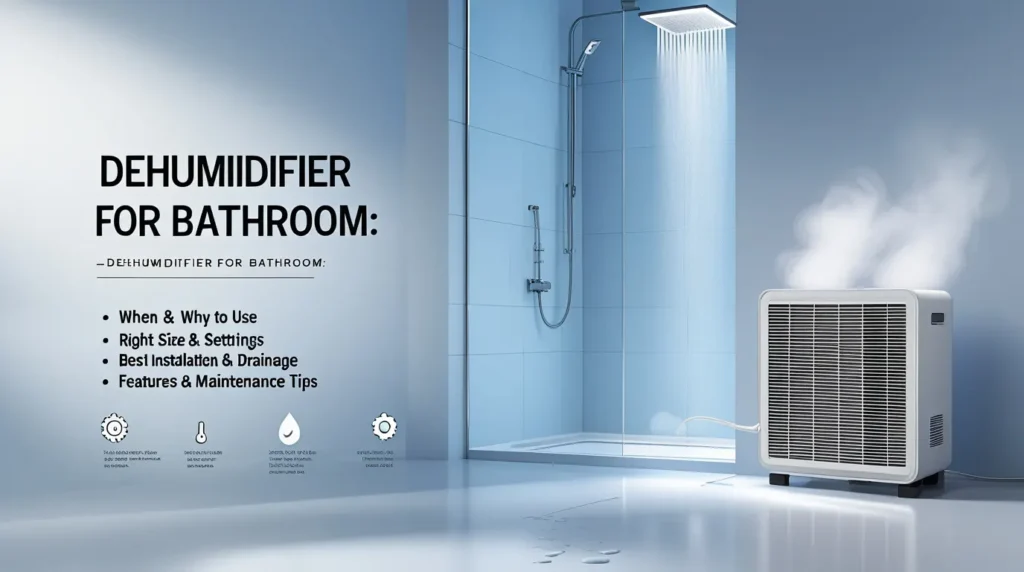Dehumidifier for Bathroom
Dehumidifiers are used to control moisture. Normally moisture comes to your home from your toilet, swimming pool and if your house is near a lake, then high moisture issues can happen to you. And because of those issues, we use dehumidifiers at home. But sometimes using dehumidifiers in rooms does not save the bathroom. Compared to other rooms, the bathroom has a higher moisture level, due to this reason algae, mold & fungi issues can happen to your bathroom wall. To avoid those problems you should go for a dehumidifier. There are few things you must follow before you buy any dehumidifier for your Bathroom.
- When you should use a dehumidifier for Bathroom.
- Choose the right size/capacity dehumidifier for Bathroom..
- Best location, position & installation process for your dehumidifier.
- Water drainage options for the dehumidifier.
- In which capacity or setting you need to operate the dehumidifier.
- How capable the dehumidifier is to operate in low temperatures, as per your Bathroom requirement.
- When you should go for a desiccant dehumidifier and if your Bathroom has an HVAC system, then how to use it with the ducted Indoor unit.
- When and why the filter of the dehumidifier need to be changed.
- What kind of features does the dehumidifier provide to operate it smoothly. Like, auto-compressor off, Auto restart, CO mode, timer option etc.
When you should use a dehumidifier for Bathroom:
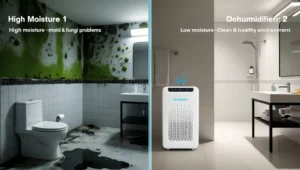
We shower, brush our teeth, wash staff, etc in the bathroom. A lot of water is used here. Due to those reasons, the moisture level in the bathroom is very high.
Proper ventilation is also required for a bathroom. We use 300CFM/400CFM/700CFM exhaust fans for the toilet/bathroom (depending on the size of the area). If you don’t use those fans, the moisture air will not be able to release from your bathroom. This can cause algae, mold, and fungi issues in your space. Also, because of that, the moisture will spread all over the house. So use an exhaust fan if you don’t have one.
If you have an exhaust fan and still face poor air quality, algae, mold, and fungi in the bathroom wall, then go for a dehumidifier.
One thing you need to see is that sometimes the draining system is a little poor in some bathrooms. If the tail is not straight in the bathroom then during taking a shower, water can stack here. If you have those problems please fix them.
How to choose the right size dehumidifier for Bathroom:

Well there are so many things to consider, when it comes to choosing the right size dehumidifier for Bathrooms. But I don’t want to make my starting calculation. After all it is just for the bathroom, not for any chips & dry fruit factories or pharmaceutical industries.
For Bathrooms or toilets you can take a 30 pint dehumidifier for 500 to 1500 square feet,
50 pint for 1000 to 1500 square feet,
and 70 pint is for a high moisture level room over 1500 square feet.
Best location and position for your dehumidifier:
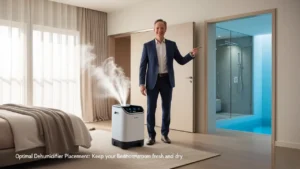
To get the best place to install the dehumidifier, you should know about the source of the moisture in your house/room. As we know here the bathroom is the main source of moisture and we are gonna install a dehumidifier in the bathroom.
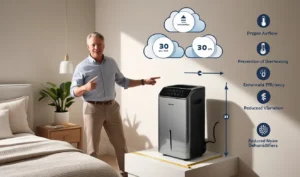
Before placing the dehumidifier, make sure there is a 30 cm gap between the wall and the dehumidifier. Otherwise air circulation issues will happen. Also after the air gets pushed by the wall, it will try to return to the dehumidifier. Which can be a cause of overheating and because of that your compressore will get damaged.
Make sure the electricity connection is safe & while showering the water can not touch the dehumidifier.
Water drain system for dehumidifier:
For water drain there are few options. You can physically change the collected water from the dehumidifier. Also you can connect a drain line with it and then connect the drain line with the toilet.
Actually there is nothing much about the drainline of a dehumidifier, when you are installing it in the bathroom. Because you can just leave the pipe anywhere in the bathroom & the water will drain easily.
There are other options like pump motors. By using a pump motor you can drain water through Basement floor to Ground floor. Now for Bathroom additional pump motors are not required, if you need you can use it. Lot of models on the market now provide inbuilt pump motors on dehumidifiers. But they are not reliable, so if your situation requires a pump motor then try to go for an additional one. They are more long-lasting and relatable.
In which capacity you need to operate the dehumidifier:
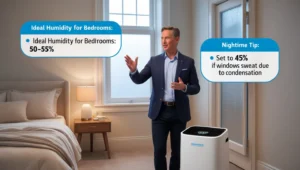
You can set 45 on your dehumidifier. This is the standard for areas like the bathroom. Because 40 is too high and 65/70 is too low.
On cold nights, water accumulates on glass windows due to condensation. On those particular periods you can set 40 on the dehumidifier. But generally 45.50 is the preferable setting.
Dehumidifiers issues at low temperatures:
There are two kinds of dehumidifier, compressor/refrigerant type and desiccant type. For the House, Bathroom and bedroom areas we use a compressor/refrigerant type dehumidifier. In low temperatures this kind of dehumidifier doesn’t work well.
Why compressor or refrigerant-type dehumidifier doesn’t work well in cold places:
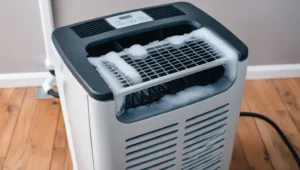
Imagine you have two Bathrooms with similar moisture/humidity levels, Bathroom A and Bathroom B. The temperature of Bathroom A is 30 degrees Celsius & Temperature of Bathroom B is 17 degrees Celsius. And you are using a 50 Pints/day capacity dehumidifier in those two Bathrooms. You will notice that in Bathroom A the dehumidifier is working well, Because it has a higher temperature. In the meantime, the dehumidifier in Bathroom B is not working well, because it’s working in very low capacity. Also if you run it for a day, you will notice that the Bathroom B dehumidifier is freezing up & stops working. Because its temperature is very low.
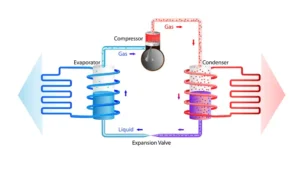
It’s happening because the refrigerant dehumidifier works with the refrigeration cycle, the chilled liquid refrigerant gas flows through the evaporator. During this process, the evaporator gets colder than the Bathroom temperature. When Bathroom moisture air comes to the evaporator, a heat exchange happens between them due to the temperature difference. Here the evaporator absorbs the heat from the Bathroom air and the moisture in the air gets cold and heavier by losing heat. Because of that, the cold heavy moisture is stuck to the evaporator and then they collect in the water pot of the dehumidifier.
But in cold weather the moisture in the air is already cold. When this cold moisture comes to the evaporator, heat exchange happens much less compared to a high temperature area. Because of that in cold areas, refrigerant dehumidifiers work in very low capacity.
And if the temperature of your area is very cold, then cold moisture can frezz-up over the evaporator.
In that condition you should go for a desiccant dehumidifier.
Nowadays every dehumidifier company tests their dehumidifier in low temperatures
(18 degree celsius/65°F). So that the maximum ability of a dehumidifier can be tested. Before that they were tested dehumidifier in 26°C/80°F. By doing this companies can find out that, in low temperature what kind of issues can happen. And they add a lot of different modes for batter control even if the dehumidifier gets frizz-up. In the end we will explain how different modes work in a dehumidifier.
Desiccant Dehumidifier:
The desiccant dehumidifier is completely different from the refrigerant dehumidifier. Basically, a desiccant dehumidifier uses silicon gel to absorb moisture from the air. Silicon gel can absorb water up to 40% of its weight. The main component of a desiccant dehumidifier is the desiccant rotor. The desiccant rotor in the dehumidifier rotates slowly. When the process air/bathroom air goes through the desiccant rotor, the silicon gel in the desiccant rotor absorbs the moisture from the air. This stuck water goes out by a different process.
If the house is too big and it has an existing HVAC system and ductwork, then you can run it with the HVAC system.
First install the dehumidifier, then connect the return duct line with it and then another duct line from the dehumidifier needs to connect with the indoor unit. So that the dehumidified air can go to the indoor unit and after getting cold it can go back to the room.
It can operate in areas where the temperature is less than 10°C. It’s a simple, practical, and easy-to-use device to control humidity in the Bathroom. It provides more efficiency, control and reliability compared to the refrigerant type dehumidifier.
There are some disadvantages also, like it is hard to install, you can’t easily change the location of it and in the beginning it cost more.
It is mostly used for industrial areas where maximum control over humidity is needed and places where the temperature is less than 18/17°C.
When and why the filter of the dehumidifier needs to be changed:
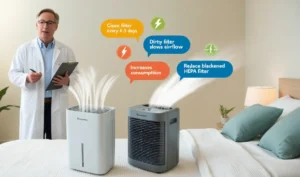
The filter of the dehumidifier needs to be cleaned between every 4/5 days. Because it gets dirty quickly. If the filter gets dirty, then the air flow will slow down which will affect the performance of the dehumidifier. Because it will not get enough air to remove the moisture. Due to those reasons, the blower fan of the dehumidifier will run faster than its regular speed. Which is the cause of more electric consumption.
If you see that the HEPA filter is getting black after long use, then just change it. There can be germs and viruses on it. This can make your Bathroom unhygienic.
Different kinds of modes to get more control over the dehumidifier:
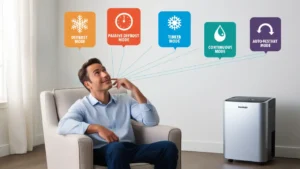
Nowadays dehumidifiers are smarter than ever. There are so many different modes that make us a smart user and we can use them to make our bathroom perfect. Like Defrost mode, Passive defrost mode, Timer mode, Continuous mode and Auto-restart mode. Here I have described them:
Defrost mode: In cold areas, sometimes dehumidifiers freeze up and for those issues, companies provide this mode. The old model dehumidifier has this setting. In cold weather, compressor-based dehumidifiers get frizzed. Defrost mode was invented to avoid this issue. what it does is, it automatically turn off the refrigeration cycle of the dehumidifier and it will only run its fan. So this fan slowly melts the ice from the dehumidifier. after the ice is fully melted, it runs again.
Passive defrost mode: Companies now provide passive defrost mode in modern dehumidifiers. It is an optimized version of the deforest mode. In this mode, the dehumidifier is not actively dehumidifying, but still, it consumes electricity. So this mode is less efficient compared to the deforest mode but provides a high value.
This mode allows the dehumidifier to operate at a very low temperature. We know that the compressor-based dehumidifier gets frizzed, if we use it in a place where the temperature is lower than 17/18 °C. But because of this mode, now the dehumidifier can run at 5°C temperature. At this temperature, it runs in a very low setting. This is crazy that modern dehumidifiers are improving so much. For more lower temperature go for the desiccant dehumidifier.
Timer mode: It’s a very common mode, most dehumidifiers on the market come with a timer. Imagine you need to go out for some work, before you go out you set the timer mode for 4 hours. After 4 hours it will turn off automatically. so that when you come home you find your place more comfortable.
Continuous mode: It is used in very humid areas like basements after rain & places where mold is a massive issue. Normally modern dehumidifier has a sensor when you achieve the required humidity level, it turns off automatically. But continuous mode doesn’t off automatically. it will run until you turn it off.
Auto-restart: Imagine you are using continuous mode or another mode on your dehumidifier and due to load shading the dehumidifier is off now. Once the power is available, the dehumidifier will run in the same mode, that you set before. Every dehumidifier has this setting.

